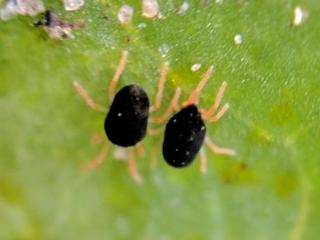Redlegged earth mites are damaging advanced crops. Timerite® can assist with spring control
- Central agricultural region
Dani Whyte (Planfarm) has been finding redlegged earth mites (RLEM) damaging cereal crops in the central agricultural region with up to 20 mites per tiller seen.
The PestFax team has received a few calls regarding this scenario over the past three weeks, of RLEM damaging advanced crops, especially cereals.
In most years peak RLEM hatching from over summering eggs occurs in mid-May but this year RLEM hatchings occurred from mid-June onwards. Crops that were treated with a post sowing insecticide were not effective against the mites by the time they hatched.
RLEM are now producing diapause eggs which go dormant over summer and carry over into the next season when they hatch in autumn. This means that RLEM that hatch next year could pose a threat to emerging crops, especially susceptible crops such as canola.
Advanced cereal crops are very tolerant to RLEM feeding damage on the leaves, however there may be yield penalties where the flag leaf is receiving significant damage and controlling RLEM now may also prevent higher populations next season.
Spring control of RLEM using Timerite®
Spraying for the control of redlegged earth mites (RLEM) in some spring pastures will have occurred in early September for some parts of the northern and central agricultural areas and will be happening now in some central and southern regions.
The timing of the sprays is based on a short window of the season when RLEM have stopped laying winter eggs (eggs that must hatch this season) and before they start laying diapause eggs (over-summering eggs able to survive until next autumn).
Controlling mites at this time means that the whole population can be affected, leaving few mites to carry-over to the following autumn.
Growers who have not already obtained their spray date that is specific to their locality can do so (free of charge) from the Australian Wool Innovation (AWI) Limited Helpline on 1800 070 099 or you can type the latitude and longitude of your property into the AWI TIMERITE® page to obtain your spray date and other useful information. Please note that the Timerite® date does not work against blue oat mite.
Studies by CSIRO have shown that spraying up to two weeks earlier or on the optimum spray date provides effective control of RLEM, however if spraying is delayed by two weeks after the optimum date the carry-over RLEM population into next autumn is much higher.
Farmers intending to spray paddocks should make the most of suitable weather conditions to go early or on time, rather than later than the predicted Timerite® date.
Entomologist Svetlana Micic (DPIRD) advises that farmers rotate chemical groups to stop resistance developing in RLEM. Repeated use of synthetic pyrethroid insecticides and organophosphates insecticides such as omethoate and chlorpyrifos provides strong selection pressure for RLEM to develop resistance. For more information see DPIRD’s Prevent redlegged earth mite resistance and GRDC's Resistance management strategy for the Redlegged Earth Mite in Australian grains and pastures.
Grazing reduces mite carryover in pastures
The level of grazing and quantity of pasture feed on offer (FOO) is directly related to the numbers of RLEM. Department grazing trials have shown that pasture grazed to 1.4t/ha FOO during spring will have low levels of mites, equivalent to numbers after spraying pastures with high FOO level.
Spraying of pastures in spring will have little or no benefit where pasture FOO levels are kept low by grazing. nsecticides applied to control RLEM infested spring pastures or legume break crops with FOO levels greater than 3t/ha, will reduce their numbers and provide benefits by allowing increased spring growth, seed set and a much reduced potential for RLEM carry-over into next autumn.
However, increased production benefits can largely be wasted unless the increased feed is utilised by strategic grazing management or fodder conservation. It is recommended that farmers should not spray all pasture paddocks but rather select paddocks for spring spraying, based on FOO levels, future grazing feed management, level of required seed production and intended paddock use next autumn.
For more information on RLEM refer to the department’s Diagnosing redlegged earth mite page.
For more information contact Dustin Severtson, Development Officer, Northam on +61 (0)8 9690 2160 or Svetlana Micic, Research Officer, Albany on +61 (0)8 9892 8591 or Alan Lord, Technical Officer, South Perth on +61 (0)8 9368 3758.

